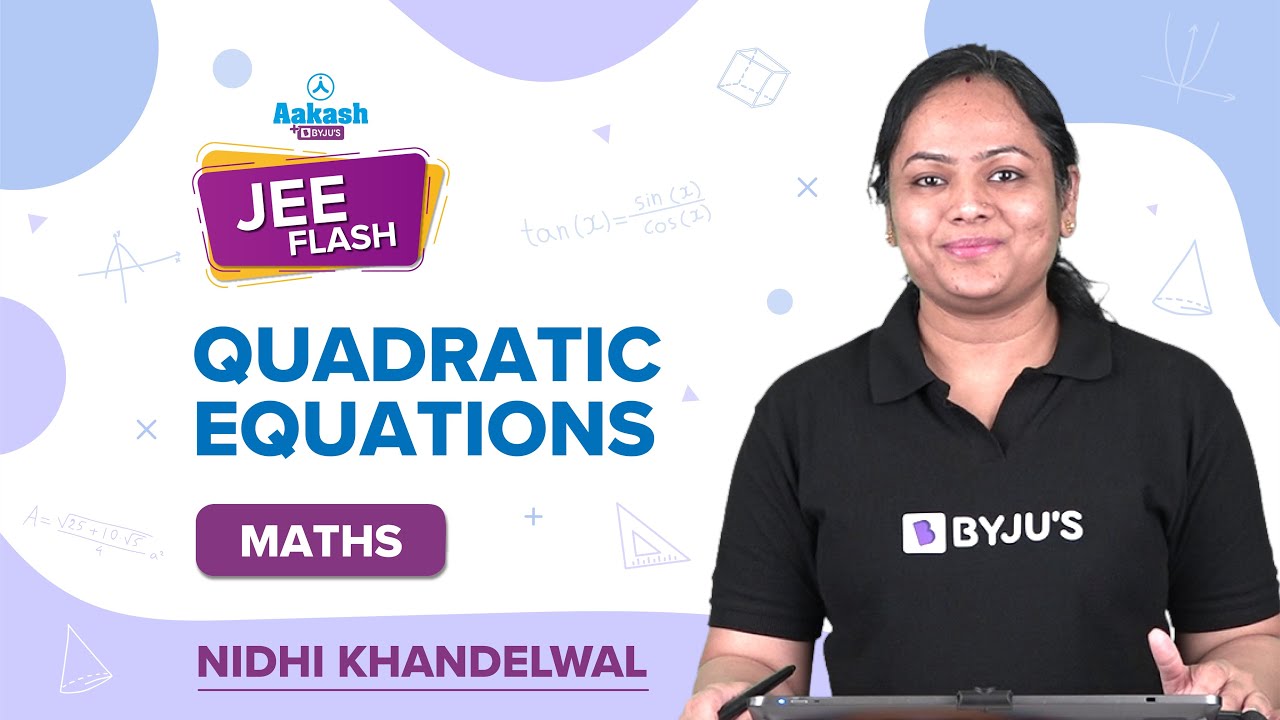JEE Advanced Maths quadratic equation previous year questions with solutions are given on this page. A quadratic equation is a polynomial equation of degree 2 in the form ax2+bx+c = 0, where a,b,c are real numbers and a is non zero. As far as the JEE Advanced exam is concerned, this is a topic of great importance. So, students are requested to learn these problems thoroughly so that they are familiar with the types of problems asked in the JEE Advanced exam, from this topic.
Download Quadratic Equation Previous Year Solved Questions PDF
Question 1: Let α and β be the roots of x2-6x-2 = 0, with α > β. If an = αn – βn for n≥1, then the value of (a10-2a8)/2a9 is
(a) 1
(b) 2
(c) 3
(d) 4
Solution:
Given x2-6x-2 = 0
α and β are the roots of above equation.
So α + β = 6
αβ = -2
Given an = αn – βn
(a10-2a8)/2a9 = [(α10 – β10) – 2(α8 – β8)]/2(α9 – β9)
= [α8(α2 – 2) – β8(β2 – 2)]/2(α9 – β9)
= [α8(6α) – β8(6β)]/2(α9 – β9) (since α2-6α-2 = 0 and β2-6β-2 = 0)
= 6(α9 – β9)/2(α9 – β9)
= 6/2
= 3
Hence option c is the answer.
Question 2: If x2 + px – 444p = 0 has integral roots, where p is a prime number, then the value(s) of p is (are)
(a) 2
(b) 3
(c) 2, 3 and 37
(d) 37
Solution:
Given x2 + px – 444p = 0
Using quadratic formula, x = -p±√(p2 + 4×444p)/2
Since p = 2 does not give the integral roots, so D must be a perfect square of an odd integer.
D = p2 + 1776p
= p(p + 1776)
Since D is a perfect square, p + 1776 must be a multiple of p.
=> 1776 should be a multiple of p.
We know 1776 = 24 × 3× 37, where p = 2, 3, or 37
Substitute p = 2, 3, or 37
When p = 2, D is not a perfect square.
When p = 3, D is not a perfect square.
When p = 37, D is a perfect square.
Hence option d is the answer.
Question 3: Let -π/6 < θ < -π/12. Suppose α1 and β1 are the roots of the equation x2 – 2x secθ + 1 = 0 and α2 and β2 are the roots of the equation x2 + 2x tanθ – 1 = 0. If α1 > β1 and α2 > β2, then α1+ β2 equals
(a) 2(sec θ – tan θ)
(b) 2 sec θ
(c) -2 tan θ
(d) 0
Solution:
x2 – 2x sec θ + 1 = 0 …(i)
=> x = [2 sec θ±√(4 sec2θ – 4)]/2
= sec θ ± tan θ
x2 + 2x tan θ – 1 = 0 …(ii)
=> x = -2 tan θ±√(4 tan2θ + 4)/2
= -tan θ ± sec θ
Since -π/6 < θ < -π/12
=> sec π/6> sec θ > sec π/12
-tan π/6 < tan θ < -tan π/12
And tan π/12 < -tan θ < tan π/6
Given α1 > β1
So α1 = sec θ – tan θ
β1= sec θ + tan θ
Given α2 > β2
So α2 = – tan θ + sec θ
β2 = – tan θ – sec θ
So α1 + β2 = sec θ – tan θ + – tan θ – sec θ
= -2 tan θ
Hence option c is the answer.
Question 4: If α is a root of the equation 2x(2x+1) = 1, then the other root is
(a) 3α3 + 4α
(b) α2
(c) -2α (α+1)
(d) none of these
Solution:
Given 2x(2x+1) = 1
=> 4x2 + 2x – 1 = 0
Let α, β be the roots of 4x2 + 2x – 1 = 0
Since α is a root of 2x(2x+1) = 1, we can write
2α(2α+1) = 1
=> α(2α+1) = ½ …(i)
α+ β = -1/2 (sum of roots = -b/a)
=> β = -½ – α
=> = -α(2α+1) – α (from (i))
= -2α2 – α – α
= -2α2-2α
= -2α(α+1)
Hence option c is the answer.
Question 5: A value of b for which the equations x2 + bx – 1 = 0 and x2 + x + b = 0 have one root in common is
(a) -√2
(b) -i√3
(c) i√5
(d) 2
Solution:
Given that x2 + bx – 1 = 0 and x2 + x + b = 0 have one root in common.
The formula to find the common root is given below.
If α is a common root of a1x2+b1x+c1 = 0 and a2x2+b2x+c2 = 0
Then
α2/(b1c2-b2c1) = α/(a2c1-a1c2) = 1/(a1b2-a2b1) …(i)
Comparing with given equations, we get
a1 = 1, b1 = b, c1 = -1
a2 = 1, b2 = 1, c2 = b
α2/(b1c2-b2c1) = α/(a2c1-a1c2) = 1/(a1b2-a2b1)
Substituting the values in (i) we get
α2/(b2 +1) = α/(-1-b) = 1/(1-b)
=> α2 = (b2+1)/(1-b) ….(ii)
α = (1+b)/(b-1) …(iii)
Put α in (ii)
(1+b)2/(b-1)2 = (b2+1)/(1-b)
=> (1+b)2(1-b) = (b-1)2(b2+1)
=> -(b-1)(1+b)2 = (b-1)2(b2+1)
=> -(1+b)2 = (b-1)(b2+1)
=> (-1-2b-b2) = (b3 – b2 + b – 1)
=> -3b = b3
=> b2 = -3
Taking square root
=> b = ±i√3
Hence option b is the answer.
Question 6: If x satisfies |x2-3x+2| + |x-1| = x-3, then
(a) x ∈ Ø
(b) x ∈ [1, 2]
(c) x ∈ [3, ∞)
(d) x ∈ (- ∞, ∞)
Solution:
|x2-3x+2| + |x-1| = x-3
=> x – 3 ≥ 0
=> x ≥ 3
x2 – 3x + 2 + x – 1 = x – 3
x2 – 3x + 4 = 0
[x – (3/2)]2 + 4 – 9/4 = 0=> no real solution
Hence option a is the answer.
Question 7: Let D = a2 + b2 + c2, a, b being consecutive integers and c = ab then √D is
(a) always an even integer
(b) always an odd integer
(c) sometimes an odd integer, sometimes not
(d) sometimes a rational number, sometimes not
Solution:
Given that a and b are consecutive integers.
So b = a+1
Also c = ab
D = a2 + b2 + c2
= a2 + (a+1)2 + a2b2
= a2 + a2 + 2a + 1 + a2b2
= 2a2 + 2a + 1 + a2b2
= 2a(a+1) + 1 + a2b2
= 2ab + 1 + (ab)2
= (ab+1)2
√D = ab+1
=> √D is always an odd integer
(ab is even number since either a or b will be even. When we add 1 to it, we get an odd number.)
Hence option b is the answer.
Question 8: If 2+i√3 is a root of the equation x2 + px + q = 0, where p and q are real, then (p, q) equals
(a) (-4, 7)
(b) (4, -7)
(c) (-7, 4)
(d) (4, 7)
Solution:
If 2+i√3 is a root of the equation x2 + px + q = 0, the other root will be 2-i√3.
Sum of roots = -p
= 2+i√3+ 2-i√3
= 4
=>p= -4
Product of roots = q
= (2+i√3)(2-i√3)
= 4 +2√3i – 2√3i + 3
= 7
So (p,q) = (-4, 7)
Hence option a is the answer.
Question 9: If the product of the roots of the equation x2 – 3kx + 2e2log k – 1 = 0 is 7, then the roots are real for k equal to
(a) 1
(b) 2
(c) 3
(d) 7
Solution:
Given x2 – 3kx + 2e2log k – 1 = 0
=> x2 – 3kx + 2k2 – 1 = 0 (since n log x = log xn, elog x = x)
Product of roots = 7
=> 2k2 – 1 = 7
=>2k2 = 8
=>k2 = 4
=> k = 2 or -2.
For real roots, k>0.
So k = 2
Hence option b is the answer.
Question 10: If the quadratic equations x2 + ax + b = 0 and x2 + bx + a = 0 (a ≠ b) have a common root, then the value of (a+b) is
(a) 1
(b) -1
(c) 2
(d) 0
Solution:
x2 + ax + b = 0 ..(i)
x2 + bx + a = 0..(ii)
If α is a common root of a1x2+b1x+c1 = 0 and a2x2+b2x+c2 = 0
α2/(b1c2-b2c1) = α/(a2c1-a1c2) = 1/(a1b2-a2b1) …(iii)
Comparing (i) and (ii) with above equations, we get
a1 = 1, b1 = a, c1 = b
a2 = 1, b2 = b, c2 = a
=> α2/(a2-b2) = α/(b-a) = 1/(b-a)
=> α = 1
So 1/(a2-b2) = 1/(b-a)
=> (a-b)(a+b) = (b-a)
=> a+b = -1
Hence option b is the answer.
Question 11: If the least and the largest real values of α, for which the equation z + α|z-1| + 2 i = 0 (z∈C and i =√(-1)) has a solution, are p and q respectively; then 4(p2 + q2) is equal to
Solution:
Let z = x+iy
Given z + α|z-1| + 2 i = 0
=>x + iy + α√((x-1)2 +y2) + 2i=0
Comparing imaginary coefficients
y + 2 = 0
y = -2
Comparing real coefficients
x + α√((x-1)2+y2) = 0
x2 = α2(x2 – 2x + 1 + 4)
α2 = x2/(x2– 2x + 5)
α2(x2– 2x + 5) = x2
=> x2 (α2 – 1) – 2xα2 + 5α2 = 0
Since x∈R , D≥0
=> 4α4 – 4(α2 – 1)5α2 ≥ 0
=> α2 [4α2 – 20α2 + 20] ≥ 0
=> α2 [-16α2 + 20] ≥ 0
=> α2 [α2 – 5/4] ≤ 0
=> α2 ∈ [0, 5/4]
=> α ∈ [-√5/2, √5/2]
then 4[p2 + q2] = 4[5/4 + 5/4]
= 10
Question 12: Let α and β be the roots of equation px2 + qx + r = 0, p ≠ 0. If p, q, r are in A.P and 1/α + 1/β = 4, then the value of |α – β| is
(a) √34/9
(b) 2√13/9
(c) √61/9
(d) 2√17/9
Solution:
Given that α and β be the roots of equation px2 + qx + r = 0
So sum of roots = α + β = -q/p
Product of roots = αβ = r/p
Given 1/α + 1/β = 4
=> (α + β)/αβ = 4
=> (α + β) = 4αβ
=> -q/p = 4r/p
=> 4r = -q …(i)
p, q, r are in A.P.
So 2q = (p+r) …(ii
Substitute (i) in (ii)
-8r = p+r
-9r = p
=> r/p = -1/9
=> αβ = -1/9
(α – β)2 = (α + β)2 – 4αβ
= (-4/9)2 + 4/9
= 16/81 + 36/81
= 52/81
|α – β| = √52/9
= 2√13/9
Hence option b is the answer.
Question 13: The equation x – 2/(x-1) = 1 – 2/(x-1) has
(a) no root
(b) one root
(c) two equal roots
(d) infinitely many roots
Solution:
Given x – 2/(x-1) = 1 – 2/(x-1)
Clearly x ≠ 1 for the given equation to be defined. If x-1 ≠ 0, we can cancel the common term -2/(x-1) on both sides to get x = 1, but it is not possible. Thus the given equation has no roots.
Hence option a is the answer.
Question 14: If a2 + b2 + c2 = 1, then ab + bc + ac lies in the interval
(a) [½, 2]
(b) [-1, 2]
(c) [-1/2, 1]
(d) [-1, ½]
Solution:
Given that a2 + b2 + c2 = 1 …(i)
We know (a+b+c)2 ≥ 0
a2+b2+c2+2ab+2bc+2ac ≥ 0
=> 1 + 2(ab+bc+ac)≥ 0 (from (i))
=> 2(ab+bc+ac)≥ -1
=> (ab+bc+ac)≥ -½ …(ii)
We know that ½ [(a-b)2 + (b-c)2 + (c-a)2]≥ 0
=> a2 + b2 + c2 – ab – bc – ac ≥ 0
=> ab + bc + ac ≤ 1 …(iii)
Combining (ii) and (iii)
-½ ≤ (ab+bc+ac) ≤ 1
Therefore (ab+bc+ac) ∈ [-½, 1]
Hence option c is the answer.
Question 15: If the roots of the quadratic equation x2 + px + q = 0 are tan 300 and tan 150, respectively then the value of 2+q-p is
(a) 2
(b) 3
(c) 0
(d) 1
Solution:
Given that x2 + px + q = 0
Sum of roots = tan 300 + tan 150 = -p
Product of roots = tan 300 tan 150 = q
We know tan (a+b) = (tan a + tan b)/(1- tan a tan b)
tan 450 = tan (30 + 15)0
1 = (tan 300 + tan 150)/(1 – tan 300tan 150)
1 = -p/(1-q)
=> 1-q = -p
q-p = 1
2+q-p = 2+1
= 3
Hence option b is the answer.
Recommended Videos
Quadratic Equations – Flash Questions

Quadratic Equations – JEE Advanced Questions

Top most Quadratic Equations Problems for JEE Advanced

Also Read
JEE Main Complex Numbers and Quadratic Equations Previous Year Questions With Solutions
Comments